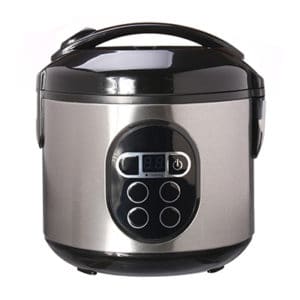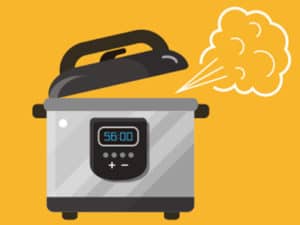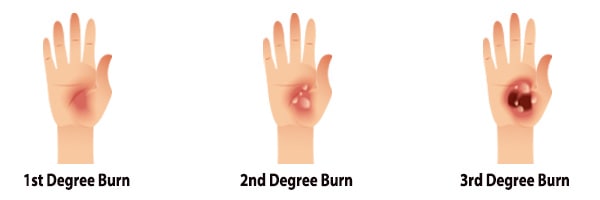Did Your Pressure Cooker Explode? Our Injury Lawyers Can Help.
The product liability lawyers at Saiontz & Kirk, P.A. investigate cases for individuals nationwide who have experienced a pressure cooker accident that resulted in burns, eye damage or other injuries.

With modern designs and available safety features, a pressure cooker lid should never be able to come off while the contents are pressurized. However, defects associated with many products sold over the past decade could make a pressure cooker dangerous and result in severe injuries, including:
- First, Second or Third Degree Burns
- Eye Injuries
- Painful Blisters
- Infections
- Loss of Skin Sensitivity
- Permanent Scarring or Discolored Skin Patches
Find out if you or a loved one may be eligible for a pressure cooker settlement. All cases are reviewed by our injury lawyers under a contingency fee agreement, which means that there are never any out-of-pocket costs to pursue a lawsuit and we only receive an attorney fee if receive financial payment!
Pressure Cooker Explosion Risks
Pressure cooking dates back to the 1600s, allowing foods to be prepared under pressure in steam or water-based liquids. However, traditionally it was understood that this process came with serious risks and pressure cooking was considered dangerous.
With the design of “spring loaded” valves, a second generation of pressure cookers were introduced that allowed multiple pressure settings and vastly improved the safety of the pots. By the 1950s and 1960s, estimates suggest that about one-third of U.S. households had one of these stove-top cookers in the kitchen, but consumer concerns about pressure cookers exploding in their face prevented more widespread sales.
This has changed dramatically since 2010, with the introduction of a modern electric pressure cookers, including Instant Pot, Tristar, Crock-Pot, Cuisinart and others. While this new generation of programmable pressure cookers are considered safer than stovetop pressure cookers, they still have the potential to be dangerous and cause devastating injuries.
These products have been aggressively promoted by manufacturers as “safe”, “easy” and “fool-proof.” However, reports of pressure cooker accidents and burns make it clear that many of these devices are not as safe as consumers were led to believe.
- Instant Pot (InstaPot) Cookers
- Tristar Power Pressure Cookers
- Crock Pot Multi-Cookers
- Cuisinart Electric Pressure Cookers
- NuWave Nutri-Pot Digital Pressure Cookers
- Ninja Foodi Pressure and Air Fryer Combo
- Elite Bistro Electric Cookers
- Bella Cucina (Home Shopping Network/HSN) Pressure Cookers
- Cooks Essentials (QVC) Pressure Cooker
- Kalorik Multi-Use Pressure Cookers
- and Others Sold Under Fagor, Breville, Prestige, Philippe Richards, Wolfgang Puck, Mirro and other Brands
How Does a Pressure Cooker Explode or Blow Up?

If the lid of a pressure cooker comes off while the unit is still pressurized, hot contents and liquids can explode in your kitchen and onto the face of anyone nearby.
Although consumers have been led to believe that modern pressure cooker safety features automatically lock the lid and make it impossible to remove the cover while the contents are under pressure, this is not always the case.
Many manufacturers placed their desire for profit before consumer well-being, by leaving available safety features off and continuing to sell faulty pressure cookers after design changes were made.
Pressure cookers fail in a few different ways:
Exploding Pressure Cooker Lids: If safely designed and manufactured, the pressure cooker lid should never blast off during normal use. However, if the top fails to seal or extreme pressure is able to build up inside the pot, the lid may blow off suddenly and unexpectedly. This can result from an electronic failure, degraded components, blocked/clogged release valve or other pressure cooker defects.
Lid Opened Under Pressure: The more common cause of a pressure cooker explosion occurs when the unit allows the lid to be rotated and opened while contents are still pressurized. In many designs, it is impossible for the user to know when the cooker is depressurized. Allowing the accidental opening of a pressure cooker will cause built up pressure, heat and steam to be released suddenly, posing an injury risk for users.
Pressure Cookers Can Be Dangerous When Safety Features Fail
A variety of modern pressure cooker features have been promoted in recent years, which were intended to encourage widespread sales of these products. It is reasonable for consumers to rely on these representations, and expect that their pressure cooker will not explode or allow the lid to be removed while pressurized
Some of the potentially defective pressure cooker safety features may include:
- Lid Locks and Safety Devices: Locks are supposed to make it impossible to remove the pressure cooker lid or unlock the device until it is completely depressurized. Systems are also supposed to prevent the cooker from pressurizing until the lid is fully secured in place. If the lid is not on correctly, the pressure cooker should switch to a “keep warm” or “sauté” mode.
- Pressure Release Valves and Anti-Block Vents: Before allowing the lid to be removed, steam is supposed to be released through a valve or vent. Consumers have been told that advanced “anti-block” features prevent clogging. Food or liquid should never be able to accumulate and prevent the release of steam through the pressure valve.
- Automatic Pressure Control: Sensor mechanisms are supposed to keep the pressure inside the cooker within a safe range. If the pressure gets too high, the cooker should automatically shut off or release steam to lower the pressure.
- Pressure Pot Lowering Features: Many pressure cookers contain features that are supposed to automatically reduce pressure if it gets too high, by dropping the inner pot. This may allow the release of steam around the rim of the lid, but should not allow hot contents to blow out of the pressure cooker.
- Auto Shut-Off Temperature Controls: When the temperature inside a pressure cooker reaches the preset value, the power should be automatically shut off to prevent further pressure from developing. Extreme temperatures should never be reached, as a fuse is supposed to automatically disconnect power before this occurs. If the user forgets to place the inner pot in the pressure cooker, if the heating element is not in good contact with the inner pot or if scorched food develops on the bottom of the pressure cooker, it should stop heating.
How Do I File a Pressure Cooker Injury Lawsuit?
Complete Our case evaluation form below, including your contact information and a brief description of your pressure cooker accident.
You will be contacted by Saiontz & Kirk, P.A. to help determine if financial compensation may be available for your injuries.
If our lawyers determine that we can help with your case, THEN YOU DECIDE whether to move forward and hire our law firm to pursue your pressure cooker case.
CONTACT OUR PRESSURE COOKER LAWYERS No Fees or Expenses Unless a Recovery is Obtained.
Allegations Raised in Pressure Cooker Class Action Lawsuits
The pressure cooker attorneys at Saiontz & Kirk, P.A. are reviewing claims for individual injuries and class action lawsuits against the manufacturers of several products widely sold in recent years. According to allegations raised in the litigation, manufacturers have:
- Sold unreasonably dangerous pressure cookers that lacked available safety features
- Grossly exaggerated safety features to minimize known pressure cooking risks;
- Failed to adequately test pressure cooker safety features;
- Used materials or designs that allow faulty pressure cooker lids to come off while the pot is pressurized;
- Withheld warnings and instructions about the pressure cooking dangers;
- Ignored or concealed information about pressure cooker accidents to continue generating profits from dangerous products;
- Failed to redesign defective pressure cookers, despite economical and safer alternative features that could have avoided problems;
- Failed to recall pressure cookers with known problems
- Prevented consumers from making an informed decision about whether the benefits of pressure cooking justify exposing themselves and their family to a risk of serious injury
Pressure Cooker Accidents and Injuries
If a pressure cooker fails and allows the lid to come off while the unit is pressurized, it may result in severe and permanent injuries for users and other family members in the area.
When a pressure cooker explodes in the kitchen, hot contents and liquids can be sprayed throughout the entire room, potentially causing eye injuries, blindness or severe burns. This can result in the need for emergency burn treatment, leaving you with painful blisters, infections, loss of skin sensitivity and scarring.
When a pressure cooker blows up it can also blast hot steam, causing scald burns on the face, arms, chest or other parts of the body. This may result in red or darkened skin patches that remain for years, if not permanently.
Although hundreds of reports have been submitted involving pressure cooker burns and personal injuries, manufacturers have continued to sell dangerous products and concealed information about the risks associated with certain pressure cookers.
Types of Pressure Cooker Injuries

First Degree Scald or Steam Burn: result in pain and reddening of the skin, often requiring medical treatments with antibiotic creams and medications. Depending on the parts of the body burned, this may result in lost wages and substantial medical bills.
Second Degree Burns and Blisters: open sores and wounds from second degree pressure cooker burns may increase the risk of scarring, and may led to infection and other complications. These injuries take longer to heal, resulting in prolonged pain and suffering. Patches of burned skin often result in permanent scarring or discolored skin colors.
Third Degree Burns: scalding hot contents from a pressure cooker can destroy layers of skin and damage nerve endings, often requiring skin grafts and lengthy burn treatments. These severe pressure cooking injuries can be disfiguring, resulting in permanent injuries and a substantial impact on your entire life.
In some cases, burns from pressure cookers can also increase the risk of other life-threatening injuries, including:
- Dehydration
- Organ Failure
- Pneumonia
- Hypotension or Seriously Law Blood Pressure
- Sepsis or other severe infection that may even result in amputation
Pressure Cooker Recalls and Safety Warnings
Thousands of consumers have experienced problems with modern pressure cookers, and federal regulators have confirmed hundreds of cases involving severe burns and injuries from pressure cookers exploding accidentally.
A number of manufacturers have been forced to issue official pressure cooker recalls, as outlined below. However, a number of other manufacturers have “silently” recalled pressure cookers, by making design changes in response to problems, without ever notifying consumers. As a result, many dangerous and defective pressure cookers remain in homes throughout the United States.
1991
First electric pressure cookers were developed, avoiding many of the serious risks associated with stove-top pressure cookers
2010s
Automatic pressure cookers were first introduced starting, with Instant Pot. This was soon followed by pressure cookers marketed by Tristar, CrockPot and others sold through Home Shopping Network, QVC, Walmart, Amazon and other retailers.
July 2015
Instant Pot Recall was issued following reports of electric shock from the pressure cooker, which was caused by a defectively designed thermal probe in the base
December 2015
Breville Pressure Cooker Recall was announced due to a defect in the sealing gasket, which may cause the pressure cooker lid to blow off and release built-up pressure.
November 2020
CrockPot Multicooker Recall impacted nearly 1 million pressure cookers, following reports of problems where the multicooker may pressurize with the lid not fully locked. More than 100 reports of problems were received, including severe first, second and third-degree burns
